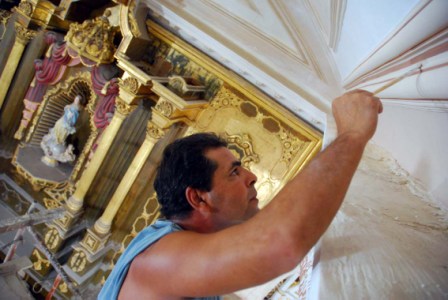Old Havana
Osmel Almaguer

Twenty years of the “Special Period” in Havana has delivered the death blow to an architecture already sufficiently battered.
When I walk through the historic district, for example, I get this strange impression that they’re never going to stop making repairs. They finish renovating one building and the previous one has already fallen into disrepair.
Yet and still, this is one of the best areas of the city, with a lot of it having to do with Eusebio Leal, the official historian of the city. He devised a tourism-based initiative through which renovation has become profitable and self-financing.
Old Havana has a large numbers of centuries-old houses, colonial fortresses and gothic churches of high architectural value. These go back to when the Spanish, rich with gold, came to the island and paid enormous sums to the most prestigious Italian and French engineers and architects of that epoch.
There are other not-so-old structures of the Republican era. El Capitolio, the University of Havana, the Latin American Stadium (the home of the Industriales team), etc. are buildings that are not only sturdy, but are representative of the city.
They are integral parts of neighborhoods like Centro Havana, Vedado and Cerro that were financed by the pre-revolutionary governments that, according to the history books, were corrupt and pocketed large portions of those development budgets.
Lastly, there are other not-so-old outlying areas, called perifericas, whose respective degrees of urban character are much less. These include East Havana, Cotorro, Arroyo Naranjo, etc., where the architecture that prevails is post-revolutionary. My neighborhood, Alamar, is another example of these.
No one paid large sums for its buildings, or maybe so, but they were huge sums distributed equally by the socialist State so that housing could be provided for everyone.
That’s why the buildings are in poor condition, not to mention their grotesque appearances (though that doesn’t have much to do with their being cheap). What’s certain is that they’re insufficient; and as families living in these places have grown, they’ve had to turn to enlarging and remodeling their State-owned apartments themselves.
The other day when I got back home, I was surprised to find that the residents on the first floor had built a room adjacent to the building. Those on the second floor took advantage of it and built their own extension on top, and the family on the third floor was already busy fashioning a terrace. It was almost a parallel building! Apart from such ad hoc architectural phenomena (emblematic of need), not everything in revolutionary architecture is negative.
A large number of schools, daycare centers and polyclinics have been built in this style. Though their quality is low (given the construction materials used) and there their aesthetics are unfortunately lacking, they’re minimally functional.
Whether the government’s efforts have been sufficient or not to maintain the nation’s architecture —which after all is the face of our country— it still lacks makeup. Or sometimes it has too much, like an old woman who wants to look younger, but fails.
